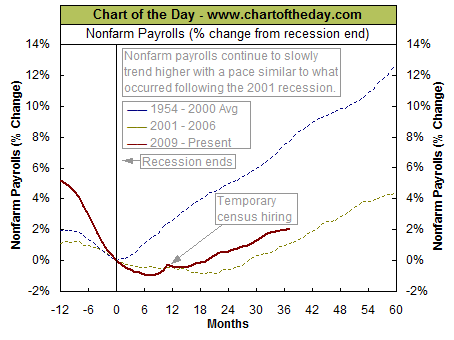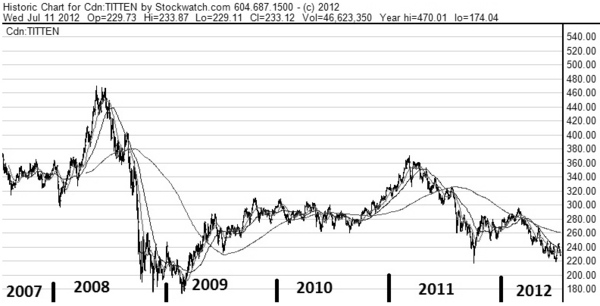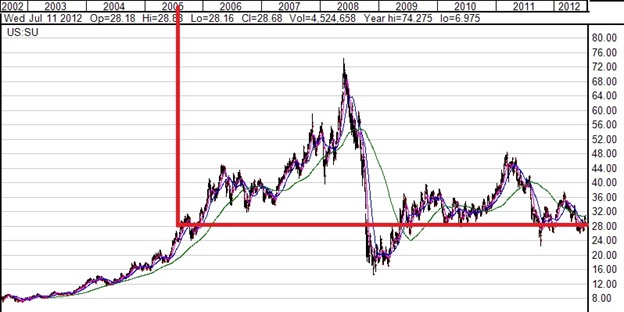Timing & trends

Bill Bonner
Since founding Agora Inc. in 1979, Bill Bonner has found success and garnered camaraderie in numerous communities and industries. A man of many talents, his entrepreneurial savvy, unique writings, philanthropic undertakings, and preservationist activities have all been recognized and awarded by some of America’s most respected authorities. Along with Addison Wiggin, his friend and colleague, Bill has written two New York Times best-selling books, Financial Reckoning Day and Empire of Debt. Both works have been critically acclaimed internationally. With political journalist Lila Rajiva, he wrote his third New York Times best-selling book, Mobs, Messiahs and Markets, which offers concrete advice on how to avoid the public spectacle of modern finance. Since 1999, Bill has been a daily contributor and the driving force behind The Daily Reckoning. Dice Have No Memory: Big Bets & Bad Economics from Paris to the Pampas, the newest book from Bill Bonner, is the definitive compendium of Bill’s daily reckonings from more than a decade: 1999-2010.
Special Report: How Will Your Life Change If The U.S. Gov’t Can’t Borrow Another Dollar? Complete political and social unrest could be just the beginning. You owe it to your family’s safety and security to watch this urgent video report right now. There might not be much time for you to act… Don’t wait, watch now.
Read more: Uncharted Territory: An Interview with Bill Bonner http://dailyreckoning.com/uncharted-territory-an-interview-with-bill-bonner/#ixzz22lSLq4rV

The latest jobs report came out today with the Labor Department reporting that nonfarm payrolls (jobs) increased by 163,000 in July. Today’s chart puts the latest data into perspective by comparing nonfarm payrolls following the end of the latest economic recession (i.e. the Great Recession — solid red line) to that of the prior recession (i.e. 2001 recession — dashed gold line) to that of the average post-recession from 1954-2000 (dashed blue line). As today’s chart illustrates, the current jobs recovery is much weaker than the average jobs recovery that follows the end of a recession. Today’s chart also illustrates that the jobs market continues to improve at a fairly steady pace — a pace very similar to what occurred following the recession of 2001.NA

Quote of the Day
“Four little words sum up what has lifted most successful individuals above the crowd: a little bit more. They did all that was expected of them and a little bit more.” – A. Lou Vickery
To Subscribe to Chart of the Day go HERE

Bill Gross runs PIMCO’s $252.2 billion Total Return Fund. With such a massive fund investing in income bearing instruments during a collapse in interest rates, its no wonder many call Gross the world’s pre-eminent bond fund manager.
As for Gross’s calls on the stock market, the chart below shows that that he was consistently wrong on his macro stock market calls. He was negative throughout the 6000 odd point Dow Rally from the Stock Market bottom in 2002. Negative again for most of another 6000 point Dow Rally from the early 2009 stock market bottom. .
Specifically Gross says that “The cult of equity is dying”, that stock investors should rethink the age-old investing mantra of buying and holding stocks for the long run. He says consistent, annual returns from stocks are a thing of the past.
Gross makes the case that stocks have averaged a 6.6% annual gain on an inflation-adjusted basis since 1912. That said he thinks that the 6.6% return was a “historical freak” that is unlikely to occur again because of slowing economic growth around the world. He says that return “belied a commonsensical flaw much like that of a chain letter or yes—a Ponzi scheme.”. In short that with growth on the US economy averaging 3.5% over that period of time, “investors were “skimming 3% off the top each and every year.”
Of the $1.8 trillion Pimco has under management in its various funds, only about $6 billion is in active equity assets.
With Gross’s track record in calling stock market moves so negative, one has to wonder if its not time to buy. Be sure to click on the chart below and view his track record.
Click on the Chart or HERE for Larger Image. To read Bill Gross’s entire commentary “The cult of equity is dying” go HERE

What’s the biggest lesson retail investors need to learn to increase profits in these markets?
It’s knowing how and when to trade volatility.
The professionals say trading volatility really is the only way to make money in a flat to down market, which the energy sector (especially the juniors!) has gone through since February 2011 – a full 16 months ago.
“A flat bear market can give flat performance, but with a lot of volatility,” says Martin Pelletier, managing director at Trivest Wealth Counsel of Calgary. “Fifty per cent to 100% swings either way are quite common.
“Unfortunately investors have reacted incorrectly – buying the tops of secular bull markets and selling the lows of secular bear markets.”
Josef Schachter, president of Schachter Asset Management Inc., says “the oil and gas sector has been good to investors – just sell during euphoria and buy during duress.”
Now of course, that’s easier said than done, and to a large degree that separates out the wealthy investors. But Schachter – who is bearish on oil for the next three to five months – says there are some turning points investors should look for in the Toronto Stock Exchange Energy Index.
TSX Energy Index 5-year chart

TSX Energy Index 1-year chart

“Given how devastated the S&P TSX Energy Index is, if it goes below 180 then it’s a great buy. We would then switch from being bears to being bulls again.
“I look at the market internals. We’re in a bounce wave now. It could go up again, but then it could go below 200 down to 180 maybe. I expect the timing on that to be the third or fourth week of October.”
Are other sectors as volatile as energy?
“From a broader perspective, if you overweighted telecom, utilities and financials you would have best risk weighted return,” says Pelletier, but adds “over the last ten years, if you were willing to accept a little more risk to get better returns, then energy is the best space to invest.”
And that means a little more active trading – even in the senior producers’ stocks.
“Just look at large cap Canadian energy stocks like Suncor (SU-TSX; NYSE) and Canadian Natural Resources (CNQ-TSX; NYSE). Both have shown a lot of volatility through the year, but there’s nothing good for those who bought and held the stock over the past five-six years.
Are other sectors as volatile as energy?
“From a broader perspective, if you overweighted telecom, utilities and financials you would have best risk weighted return,” says Pelletier, but adds “over the last ten years, if you were willing to accept a little more risk to get better returns, then energy is the best space to invest.”
And that means a little more active trading – even in the senior producers’ stocks.
“Just look at large cap Canadian energy stocks like Suncor (SU-TSX; NYSE) and Canadian Natural Resources (CNQ-TSX; NYSE). Both have shown a lot of volatility through the year, but there’s nothing good for those who bought and held the stock over the past five-six years.

“It’s been even worse for junior oil and gas have even more volatility given their greater capital demand. They typically spend 2x-4x their cash flow on exploration.
“Therefore buy and holding juniors is not the way to play them at all – you have to trade them to manage risk,” because when the market turns down, they can’t raise money to bridge the gap between exploration spending and cash flow – so the junior stocks get hit really hard.
The junior oil and gas market has definitely turned down – but for how long?
Schachter says, “If they (national governments) face the music (on their debt issues), we could see a multi-year bull market in energy through to 2015-2016 and set all-time highs. But if they just continue to kick the can down the road, then the market malaise could drag out with trading rallies and year end bounces, and you’ll need a trading mentality, as we’ve had a good year then a bad year.”
Pelletier believes there is another two to three years to go before the next secular bull market in the major indexes and energy markets – it’s a traders market until then.
But the juniors will once again have their day, says Pelletier.
“Juniors will outperform when the market returns to normality especially those with good management teams with attractive growth profiles.
“Interestingly, there is an opportunity among those who have sold off from their financings. We think these companies will be able to take advantage of this market environment and consolidate. And there are some other stories well liked among my peers which we think are attractively valued – we think it’s important to own stocks everyone likes that are backed up by strong fundamentals.”
In Part II, both Schachter and Pelletier will share some of their favorite investment ideas going into the last half of 2012.
Keith Schaefer will make a newsletter presentation and present an expert view in two sessions on Friday, Sept. 21, during the Chicago Hard Assets Investment Conference.
About the Author
Keith Schaefer, Editor and Publisher of Oil & Gas Investments Bulletin, writes on oil and natural gas markets – and stocks – in a simple, easy to read manner. He uses research reports and trade magazines, interviews industry experts and executives to identify trends in the oil and gas industry – and writes about them in a public blog. He then finds investments that make money based on that information. Company information is shared only with Oil & Gas Investments subscribers in the Bulletin – they see what he’s buying, when he buys it, and why.

The key pattern that is always the final warning sign of the collapse of a society becomes most self-evident within two primary factors:
1) The Rule of Law
2) The rise in taxation
Ed Note: A few clips below and the conclusion paragraph from this potent analysis…….highly recommend you Go HERE to read the entire fascinating work.
‘Each is fueled by government waste and inherent corruption. Japan has been the bastion of inherent political corruption”.
“The motives of such corrupt individuals, drawn to the public sector by its corruption, power, and the ability to strike deep and fatal wounds at those in the private sector, is often simply to get even with those in the private sector whose success they truly despise.
Today, “the socialism (Western Governments) have adopted as the justification of their usurpation of power is collapsing and crumbing into dust all around us. The excuse is always the “rich” have not paid their “fair” share, as if they should be willing to turn-over all their assets to support public servants that contribute nothing to the wealth of a nation”
As they say those who cannot do teach and those that can – just do. Perhaps that old saying needs to be revised by stating – those who cannot make it in the real world, hide in the bowel of government resentful of the fortunes of others regardless of merit”. ”
The Japanese Democratic Party of Japan took office in 2009 pledging not to raise taxes, curtail bureaucracy and give more power to citizens. “As with every political promise, it is just always bullshit”. Last month, Prime Minister Yoshihiko Noda pushed through the ministry’s decade-old plan to double the sales tax. “For you see, behind closed curtains, it is always the rank & file of the bureaucracy that truly dictates the course of government”.
This new policy, to double the five percent tax, ” is meant to shore up the future of bureaucrats” – not reverse the declining economy.
“Socialism adopted in ALL westernized economies is the same economic mistake as communism. It simply takes longer to get to the same place – bankruptcy” . The 50-fold export-led expansion in the Japanese economy between 1955 and 1990 was by no means their creation. We see the same in all other countries as well. “Global trade simply expanded largely due to the socialism in the USA that saw World War II usher in the payroll tax in America”.
“Like Goldman Sachs has infiltrated governments worldwide, in Japan it is MOF (Ministry of Finance) that is close to the bankers and it is the MOF that has always controlled government. Kenji Eda published a book in March entitled: “Finance Ministry Mind Control: The frightening methods of finance ministry bureaucrats, who brainwashed Prime Minister Noda to engineer the tax increase.” This indicates the truly realization of what is taking place in Japan and why Japan will collapse into a final 26 year economic low”.
Our long-term outlook in Japan for the NIKKEI 225 Cash Stock Index has remained bearish since 1989.95. Our long-term cyclical models show the first window of opportunity for a final major low remains that of 2013 with a possibility of extending into 2014 where we also have a Directional Change for the year. We are looking at a sharp increase in volatility starting in 2013 and running through into 2015. Volatility will rise again starting in 2018 and build into 2020, but it should remain high into 2023. It is possible that if the Nikkei fails to make new lows into 2013-2014, then it could extend the decline into 2017. Ideally, such a bear market reaches its conclusion within the 23 to 26 year window, which extends the bear market into 2015 with the top of the Economic Confidence Model. The target support lies at 6500-6100 followed by 4000-3800. This is further confirmed by our Yearly Bearish Reversals at 6957 and 4038. Therefore, reaching these price objectives within the ideal time frame will greatly enhance the prospect that the final low has at last been established.
….read the whole analysis including charts HERE















